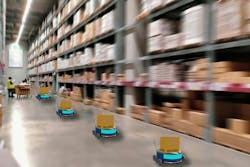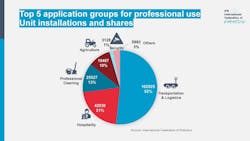Transportation Top Use for Robots
Robots are becoming an increasing part of many industries. One particular driver is a staffing shortage, which leads companies to use robots designed for trained professionals.
This, along with other factors, led to a 9% increase in the total number of service robots sold for professional use in 2024. The number reached almost 200,000 units in 2024, according to the World Robotics 2025 Service Robots report by the International Federation of Robotics (IFR).
Top applications
The number of robots built for transportation and material handling was up 14% to 102,900 units in 2024. This is more than any other professional service robot
Transportation in indoor environments without public traffic qualifies as the most important application class within this segment.
Hospitality robots remain in second place with more than 42,000 sold – down 11%. Robots for mobile guidance, information points in public environments and telepresence account for the majority of these robots. Such service robots are taking over small services or promoting sales in stores, shopping malls, or at front desks. As the sector is evolving, new applications have emerged, such as food and beverage preparation.
The market for professional cleaning robots, in third place, grew by 34% to more than 25,000 units sold. The main application is floor cleaning.
Sales of agricultural robots rank fourth and contracted slightly by 6% with close to 19,500 units sold. The decrease was mainly driven by cultivation and milking.
For the application group of search & rescue, security robots, a total number of 3,100 units were sold in 2024, placing it in fifth position, up 19%. Three out of four robots in this application class were for security services.
Medical Robots
In accordance with the ISO standard, the World Robotics 2025 yearbook considers medical robots as a third category alongside service robots and industrial robots: Sales of medical robots increased strongly by 91% to around 16,700 units in 2024.
Sales of rehabilitation and non-invasive therapy robots were up 106%. Demand for surgery robots rose by 41% and sales of robots for diagnostics and medical laboratory analysis increased by 610%.
“In a special chapter of the World Robotics 2025 report, we focus on the exciting opportunities presented by the automation of medical laboratories,” says Dr. Werner Kraus, chair of the IFR Service Robot Committee, in a statement. “In times of labor scarcity, service robots help to reduce manual labor and open up new ways to deal with the rising demand for medical services from the rapidly growing elderly population.”
"There is strong demand for service robots in a number of different application areas,” says Takayuki Ito, president of the International Federation of Robotics, in a statement. “In order to integrate automation without making a heavy upfront investment, more-and-more companies are deciding to enter into subscription or rental agreements rather than purchasing robots outright. The robot-as-a-service fleet (RaaS) has grown impressively by 31%.”

